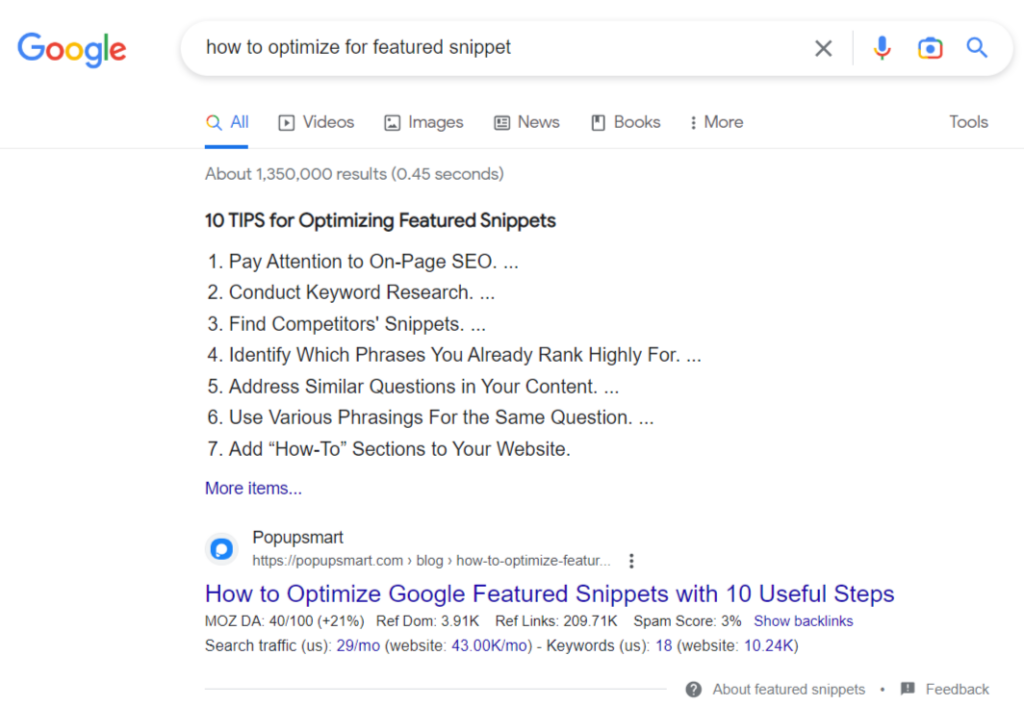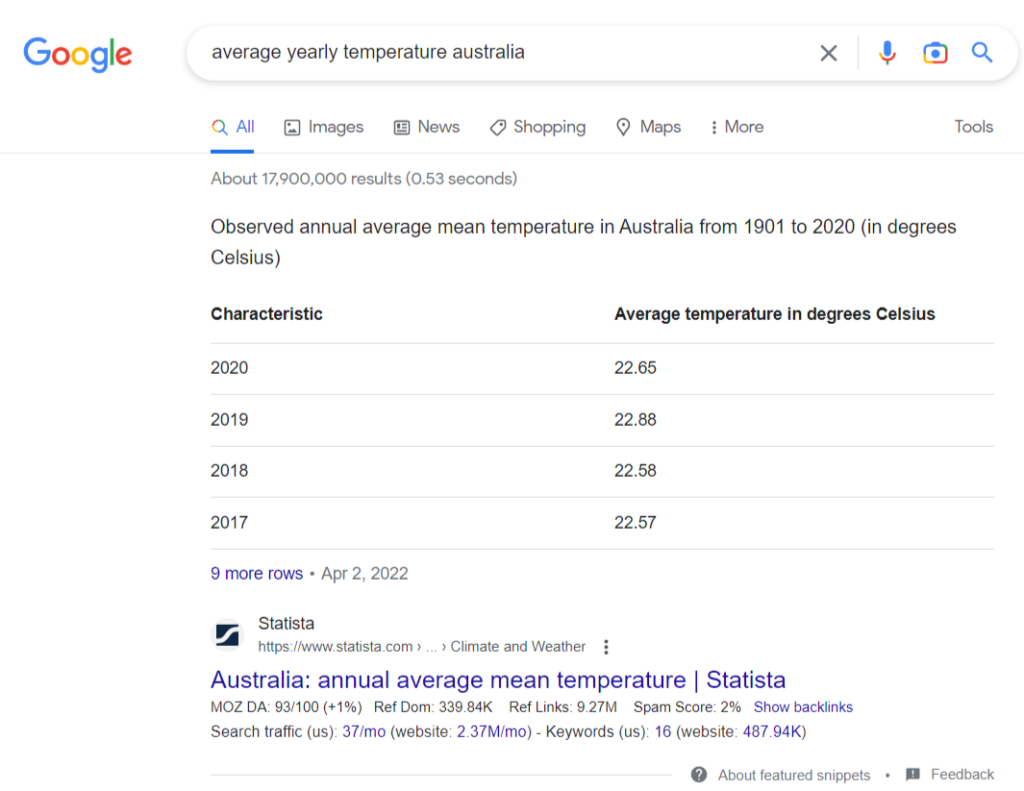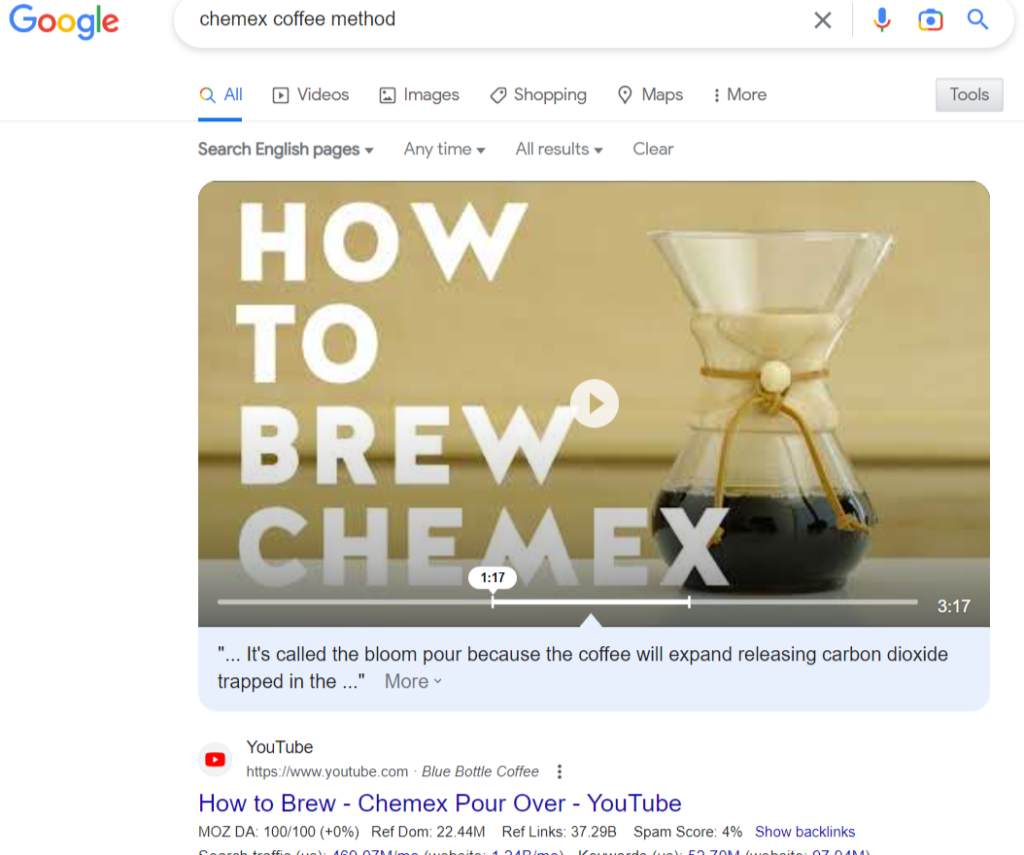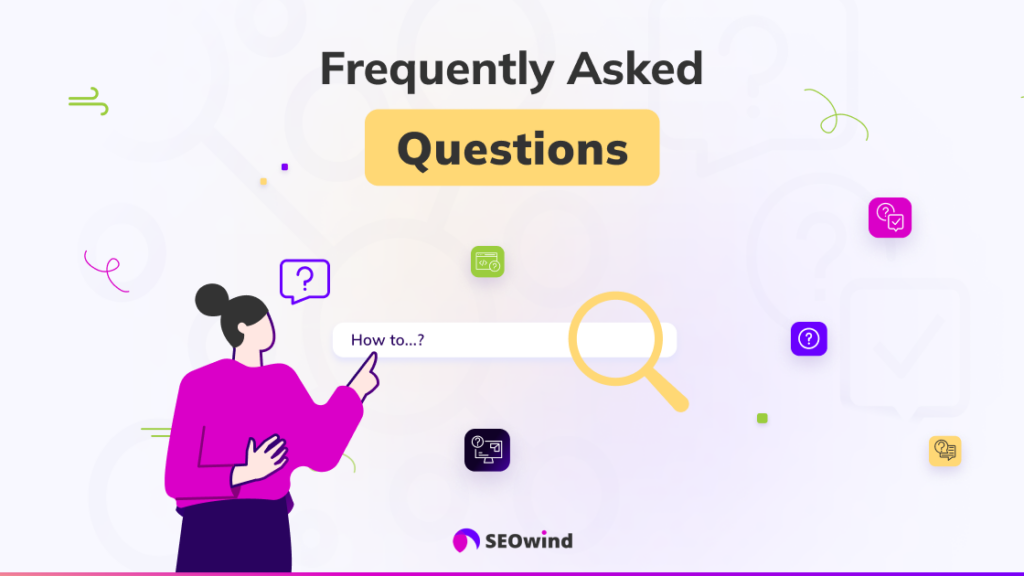Optimizing for Featured Snippets can catapult your website to the top of search results, making it an essential strategy for any digital marketer or content creator. In this complete guide, we’ll break down the world of featured snippet optimization, demystifying strategies you can use to increase traffic and gain authority for your website. With expert tips and examples at every turn, even a beginner in search engine optimization (SEO) will become proficient in optimizing their site to grab that coveted position on Google search results.
What Are Google Featured Snippets?
Featured snippets are blocks of information displayed by Google at the top of search results pages. They provide users with quick and accurate answers to their queries without requiring them to click through multiple websites – essentially offering a summary or explanation relevant to their question. For many marketers and website owners, claiming that “position zero” has become a crucial goal as it places your content above all other organic search results, boosting visibility and positioning your brand as an expert.

Considering various featured snippets available – such as paragraphs, listicles, tables, and video formats – and knowing how each type works is vital to optimizing your site effectively. The good news is we’ve got you covered! In the following sections, we’ll dive into why featured snippets are so crucial while exploring ways you can optimize your content for optimal visibility on Google’s organic results. So let’s begin our journey toward mastering featured snippet optimization!
Why Are Featured Snippets Important?
For several reasons, featured snippets are significant in search engine optimization (SEO). First and foremost, they appear at the top of Google’s search results, occupying what is often called “position zero.” This prominent placement ensures that your content gets maximum visibility, potentially leading to increased site traffic and higher click-through rates (CTR).
Moreover, featured snippets provide users with concise, relevant answers to their queries, enhancing the user experience. A well-crafted snippet will satisfy the searcher’s immediate need and entice them to explore your website further for more information.
In addition, earning a featured snippet spot lends credibility and authority to your website. Users tend to trust sites showcased by Google in this manner, making it an effective method for brand building and establishing trust within your target audience.
Lastly, with Google Assistant and other voice-activated technologies becoming increasingly popular among users, featured snippets play a vital role in voice search SEO. These digital assistants often use information extracted from featured snippets when answering user queries through voice commands.
Do Featured Snippets Lead to Increased Site Traffic?
A common question surrounding featured snippets is whether they have the potential to drive more traffic to websites. According to studies conducted by Ahrefs, owning featured snippets indeed increase organic traffic compared to ranking in the 1st position without a snippet. However, acquiring a featured snippet doesn’t guarantee exceptional CTR improvements; it primarily depends on how effectively you optimize your content for relevance and engagement.
Nonetheless, considering their positioning on search result pages and the growing prominence of voice search technology, optimizing for featured snippets remains crucial for businesses seeking competitive advantage online. By doing so, you can enhance brand visibility on the search results page while providing valuable information that encourages users to interact with your site.
In conclusion, featuring prominently in Google’s starred search results through snippet optimization has much to offer—better visibility, enhanced user experience, increased authority and credibility, and opportunities to tap into emerging voice technology trends. All these factors work together to make featured snippets essential for businesses in today’s competitive digital landscape.
4 Types of Featured Snippets
To successfully optimize your content for Google’s featured snippets, it’s essential to understand the different types available. You can tailor your content by knowing the various formats and how Google uses them to display relevant information. This section will cover four major types of featured snippets: paragraphs, listicles, tables, and videos.
Paragraph Featured Snippets
Paragraph-featured snippets are the most common type displayed on Google search results pages. They provide a brief answer or summary responding to a specific search query. The text is typically extracted from one of the top-ranking pages and presented within a bordered box as a concise response.
For paragraph-featured snippet optimization, ensure your content delivers clear and concise answers to commonly asked questions related to your topic. Distill vital information into an easily digestible format without compromising detail or accuracy.
Below you can find an example of the paragraph featured snippet for the search query “workplace change management” by Yarooms.

Listicle Featured Snippets
List-featured snippets appear when users search for specific instructions or seek enumerated data points. These snippets help break down complex topics into more straightforward steps or lists, making it easier for users to access the desired information quickly.
Optimizing for listicle snippets requires attention to two key factors:
- Logical structuring: Ensure that your numbered or bulleted lists are well-structured and organized in a logical order.
- Clear headings: Use descriptive headings and subheadings which convey what each step entails.
Incorporating these elements into your content creation process will increase your chances of securing a listicle-featured snippet position.

Table Featured Snippets
Table-featured snippets are crucial when users seek comparative data or statistics on different items. Google extracts relevant information from multiple sources and presents this data in an easily consumable tabular form highlighted at the top of search results.
Improving your chances of earning table snippets involves:
- Including tables with properly formatted headers in your content
- Ensuring that your table contains accurate, relevant, and up-to-date information
- Making the table easily accessible on your web page
Remember that even if Google develops its table for a featured snippet, using well-structured tables within your content may positively impact visibility and search ranking.

Video Featured Snippets
The video-featured snippet comes into play when specific answers or solutions are best explained through visuals or demonstrations. These snippets showcase a segment from a YouTube video directly addressing the user’s search query.
To optimize for video snippets:
- Strategically use keywords: Incorporate specific keywords into the video title, description, and tags.
- Add timestamps: Create accurate timestamps signifying important moments in the video description for quicker navigation.
- Transcript availability: Offer an accompanying text transcript to encourage better indexing by Google’s algorithms.
By thoroughly understanding these four featured snippets and implementing tailored optimization strategies based on each one’s unique characteristics, you’ll significantly increase your chances of earning prime real estate at the top of Google search results.

How to Find Featured Snippet Opportunities
Discovering featured snippet opportunities is just as important as optimizing your content for them. By understanding how to identify these opportunities, you can strategically create content that’s more likely to appear in Google’s featured snippets. Follow these steps to uncover the potential for featured snippet optimizations:
- Use Keyword Research Tools
Popular keywords research tools like Ahrefs, SEMrush, Google Search Console, and Moz provide valuable data on current search trends and page rankings. These platforms often have dedicated features that show related keywords, keywords with existing featured snippets, or highlight possible snippet candidates.
- Analyze Competitor Websites
Examine the top-ranking websites within your niche and observe which of their pages rank in the featured snippet position. This competitive analysis helps determine what topics will most likely result in a featured snippet, allowing you to tailor your content accordingly.
- Identify Questions Relevant To Your Niche
Featured snippets frequently display answers to common questions asked by search engine users. Fortify your SEO strategy using Google Autocomplete or AnswerThePublic to generate popular queries related to your industry or topic.
- Track Current Snippets That Need Improvement
Regularly monitor existing search results with featured snippets that could benefit from enhanced readability, formatting, or additional information – factors Google might consider when determining snippet eligibility. This technique offers insight into where improvements can be made.
Although it may initially seem challenging, finding promising featured snippet opportunities becomes easier once mastered, boosting your online visibility and credibility within specific industries or areas of interest. Remember, consistency and dedication are essential when pursuing this coveted position––so keep refining your approach toward effective snippet optimization strategies!
16 Featured Snippet Optimization Tips
Incorporate Question Headings

Tom Winter, CGO, SEOwind.io
One effective way to optimize your content for featured snippets is to use question headings throughout your article or blog post. This approach not only makes your content more accessible for readers but also helps search engines understand and index your content better. When you structure your content with question-centric subheadings, you answer users’ queries directly, increasing the likelihood of your content ranking for featured snippets.
First, research the most common questions and queries related to your topic. Use tools like:
- Google’s “People Also Ask” feature,
- Answer the Public,
- SEOwind (which collects questions from Google, Quora, and Reddit)
and keyword research tools to identify popular and trending questions. Once you have a list of potential questions, incorporate them into your content as subheadings or H2 tags. This will make your content more relevant and targeted to users’ search queries.
When using question headings, providing concise, clear, and accurate answers is essential. Focus on delivering valuable information that addresses the user’s query directly. Remember that search engines prioritize content that provides the best possible answer to a user’s question. Be sure to use simple language and avoid complex jargon, as this can affect your content’s readability and the likelihood of being chosen for a featured snippet.
Simple and Always With the Flow

Marco Genaro Palma, Co-founder, TechNews180
Keep your language straightforward, and do not exaggerate or embellish. Implement your keywords alongside the natural flow of the topic you are writing about. Within 40-60 words, answer questions considering your targeted keywords whenever possible. By responding briefly and clearly, Google can easily recognize the content and determine if it answers the question.
A featured snippet from our website on startup valuations: “The valuation of minicorns ranges between $100 million and $1 billion. It is common for these startups to have very ambitious goals and visions. They aim to transform, modernize, and improve the world.”
Focus on Answering Specific Questions

Jason Moss, President and Co-founder, Moss Technologies
Featured snippets often respond to a user’s search query as a question, such as “What is the best way to do X?” or “How do I do Y?” To increase your chances of getting featured snippets, focus on creating content that directly answers these questions.
This means structuring your content in a way that answers the question in a concise and easy-to-understand manner. You can also use formatting elements like lists or tables to make your content more scannable and easier to digest for users and search engines.
Additionally, including the question in the heading or subheading of your content can help improve the relevance of your content and increase the chances of getting featured in a snippet.
Provide Concise, Clear Answers

Michael Lazar, Executive, ReadyCloud
One tip I can confidently share with you is to focus on providing concise and precise answers to commonly asked questions in your niche. This requires thorough keyword research and understanding the intent behind the search queries. Once you have identified the questions you can answer in a few sentences, you can create content that provides a direct and relevant response.
For instance, I was working with a client in the health and wellness niche, and we wanted to get a featured snippet for their website. So, we researched the most commonly asked questions related to their products and services and created a blog post that provided a straightforward answer to each question. We used simple language and headings to make the content easy to read and understand. And within a few weeks, our efforts paid off, and our blog post was featured as a snippet for one of the most searched questions in the niche.
Optimize Your Content to Get on Page One
Ensure it ranks on Google’s first page to stand a higher chance of featuring your content. A majority of featured snippets you can source from high-ranking pages. Implement best SEO practices, such as incorporating relevant keywords, optimizing meta tags, and using descriptive headings.
Discover related keywords to understand your audience’s needs and focus on crafting valuable content that meets their needs. Make sure your site is mobile-friendly and loads quickly, as these factors contribute significantly to ranking higher in search results.
Center Content Around a Question
Google often presents its users with answers extracted from informative articles. Targeting queries can be advantageous when securing a featured snippet — start by identifying commonly asked questions related to your topic.
Create engaging content that maps out clear solutions in simple terms while maintaining relevance throughout the piece. Aim to provide comprehensive but concise responses that lend themselves well to Google’s curation process.
Stay Focused on the Question Throughout the Piece
Although digressing may be unintentional or even necessary, retaining focus within your writing maximizes reader engagement and stays relevant according to Google’s algorithms. As you work through an explanation or series of steps, ensure you never stray too far from addressing the initial question.
Answer Related Questions
Once you have effectively answered one search query with quality content, consider tackling related questions that users might ask next. This strategy positions you as an expert source within the field while increasing the likelihood that Google features multiple sections from your article in consecutive searches.
Write Short and Succinct Answers
Google’s algorithms often prioritize concise responses structured to provide maximum information within a short space. Although crafting the perfect answer may take some practice, consider that elegantly informative passages often outperform lengthier, less streamlined content when it comes to being featured by Google.
Include FAQ Schema
Implementing the FAQ (Frequently Asked Questions) schema into your website can increase your chances of appearing as a featured snippet. Adding this structured data markup to your page provides search engines with an easily parseable summary of answers commonly sought by users.
Format Your Content for Featured Snippets
Ensure that every aspect of your text adheres to Google’s formatting preferences by incorporating numbered lists or bullet points when relevant. Use tables whenever appropriate — particularly for presenting comparative data or orderly rows of figures.
Format List Posts Properly
When creating content to be presented as lists, structure the layout accordingly with ordered or unordered elements. This method makes it simpler for search engine crawlers to extract relevant sections of your post for inclusion in listicle-style snippets.
Include Tables
By using tables effectively, you make complex information more digestible while simultaneously optimizing content for table-focused snippets. From numerical comparison charts to categorical breakdowns, suitably formatted tables dramatically increase reader comprehension and snippet potential.
Add a Table of Contents with Anchor Links
Utilizing anchor links and providing a table of contents keeps articles organized and facilitates quick navigation between chosen subtopics. Google also appreciates this user-optimization technique when considering sources.
Leverage Images
To improve your online visibility and stand out from the competition, follow these steps:
- Identify low-hanging keywords: Start by researching keywords that are relevant to your content and have a lower competition level.
- Write a unique, experience-backed answer: Use your expertise and personal experiences to create a well-written, informative answer. Make sure it addresses the target keyword effectively and provides valuable insights to the reader.
- Include a relevant image: Enhance your answer with a high-quality, relevant image that complements your content. This can help capture the reader’s attention and make your content more engaging.
- Optimize the image’s alt text with target keywords: When adding the image to your content include the target keywords in the image’s alt text.
Understand the “Also covered on this page” section
Another important update from Google is the introduction of the “Also covered on this page” section found underneath featured snippets in specific search results – highlighting sub-headings or headings from a webpage relevant to user search queries. This addition creates opportunities for improved visibility as it presents several contextual links within a single webpage.
Here are some strategies you can employ to boost your chances of featuring in the “Also covered on this page” section:
- Optimize H2 and H3 tags: Ensure you optimize headings and subheadings with relevant keywords, ensuring they represent the content within each section.
- Leverage semantic search: Incorporate related terms and synonyms for your target keywords – enhancing topical relevance while aiding Google in understanding your page’s context.
- Promote comprehensive coverage: Create well-rounded content that delves into various dimensions concerning a particular topic.
Featured Snippets Optimization with Google Search Console
Google Search Console (GSC) is a powerful tool that helps webmasters monitor, maintain, and troubleshoot their website’s presence in Google Search results. In this section, we’ll discuss how to use Google Search Console to optimize your content for featured snippets effectively.
1. Identify potential featured snippet opportunities
The first step in optimizing for featured snippets is to identify queries for which your website is already ranking well but not yet featured. You can do this by:
- Log in to your Google Search Console account and click on the “Performance” tab.
- Set the date range to the last 3 months to get a good sample of your recent search data.
- Scroll down to the “Queries” section and click on the “Impressions” column to sort the queries by the highest number of impressions.
- Look for queries where your website is ranking within the top 10 search results, as these have the highest chances of getting picked as a featured snippet. Make a list of these queries, and prioritize them based on search volume, relevance to your business, and the potential to provide value to users.
2. Analyze existing featured snippets for your target queries
For each query on your list, perform a Google search and study the existing featured snippet, if any. Take note of the following:
- The format of the snippet (paragraph, list, table, or video)
- The content structure and length
- The use of images or multimedia elements
- The source of the snippet (competitor or authoritative website)
This analysis will help you understand what Google considers valuable and relevant content for that specific query and give you insights into what you need to do to create or improve your content.
3. Optimize your content for featured snippets
Based on your analysis, update your content to make it more suitable for featured snippets. Some tips to consider include:
- Structure your content clearly with headings and subheadings, using appropriate HTML tags (H1, H2, H3, etc.)
- Provide a concise and direct answer to the query within the first 100 words of your content.
- Use bullet points or numbered lists for easy readability when appropriate.
- Include relevant images, infographics, or videos to enhance your content’s value.
- Format data and statistics in tables when applicable.
- Add schema markup to your content to help Google understand it better.
Remember, optimizing your content for featured snippets doesn’t guarantee that Google will choose it. However, following these best practices will improve your chances of getting featured and provide a better user experience for your website visitors.
4. Monitor your progress
After optimizing your content, it’s essential to monitor your progress in Google Search Console. You can track the performance of your target queries by:
- Going back to the “Performance” tab in GSC and applying a filter for each query you’re targeting.
- Analyzing the metrics such as impressions, clicks, and average position for each query to determine if your optimizations are having any impact.
- Continuously monitoring the search results for your target queries to see if your content gets featured as a snippet.
5. Perform ongoing optimizations
Featured snippet optimization is an ongoing process. Regularly review your Google Search Console data, analyze your competitors’ snippets, and keep your content up-to-date to stay ahead in the ever-evolving landscape of SEO.
Frequently Asked Questions (FAQs) For Google Featured Snippets

Why Might Feature Snippets Be Removed?
There are several reasons why Google might remove a featured snippet might from the search results:
- Quality issues: If the content is outdated, inaccurate, or of poor quality, Google may remove the featured snippet.
- Irrelevant information: The content may no longer match user intent or address the query effectively.
- Algorithm changes: Google continually updates its algorithm to provide users with more accurate and valuable information; an update could affect your featured snippet eligibility.
- Competition: A more relevant, up-to-date piece of content may outperform yours and replace it as the featured snippet for a particular search query.
To maintain your featured snippets, ensure you consistently update and improve your content, keeping it relevant and user-focused.
Are Featured Snippets Available for E-commerce Products or Category Pages?
While less common than informational-based queries, featured snippets are available for e-commerce products and category pages. To optimize your e-commerce pages for featured snippets, focus on providing helpful and well-structured content that addresses common questions shoppers have about specific products or categories.
Consider these approaches:
- Including detailed product descriptions with benefits and unique selling points
- Offering comparison tables highlighting differences between similar products
- Using structured data markup to provide additional context around pricing and product availability
Stay attentive to competitor performance in SERPs as well – ensuring you offer high-quality content can help drive traffic crucial to e-commerce success.
Featured Snippets Vs. Rich Snippets: What’s The Difference?
Though sometimes confused, there is a notable difference between featured snippets and rich snippets:
- Featured Snippets are answer boxes displayed at the top of search engine results pages (SERPs), providing quick answers extracted from web pages without users needing to click through. They are precious as they claim prime real estate on search result pages, increase click-through rates (CTR), and boost site traffic.
- Rich Snippets enhance traditional organic search results by including additional information like customer reviews, event details, product price, or availability. You can generate them using structured data markup on your website to provide Google with further context about the content of a page.
Both aim to improve user experience on SERPs, assisting in making informed decisions before clicking any link.
How do you optimize a table-featured snippet?
The table featured snippets display data from a webpage in tabular format. To optimize for this type, follow these steps:
- Identify opportunities: Research queries that could benefit from tabular representation, such as comparison or pricing-based searches.
- Create well-formatted tables: Ensure your tables are formatted and easy to read; use header rows and columns to define a hierarchy within the table.
- Keep it brief but informative: Tables should be concise yet contain vital information relevant to users’ search intent.
- Use captions and descriptive headers: Descriptive labels help Google understand the purpose of your table and identify its relevance to specific search queries.
- Leverage structured data where possible: Implementing schema markup can improve how Google interprets your table’s content.
Following these guidelines will enable you to optimize your content for table-featured snippets, driving increased CTRs and site traffic.



